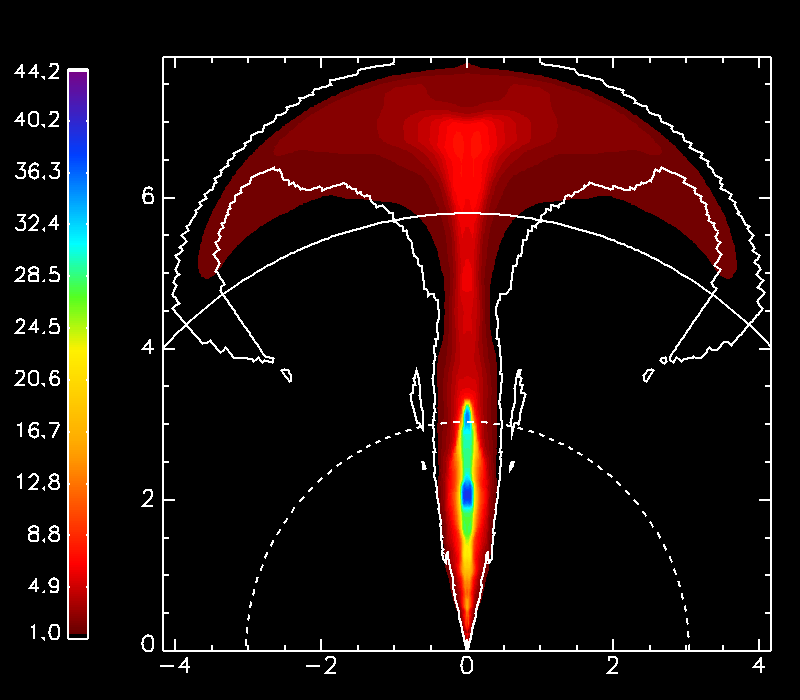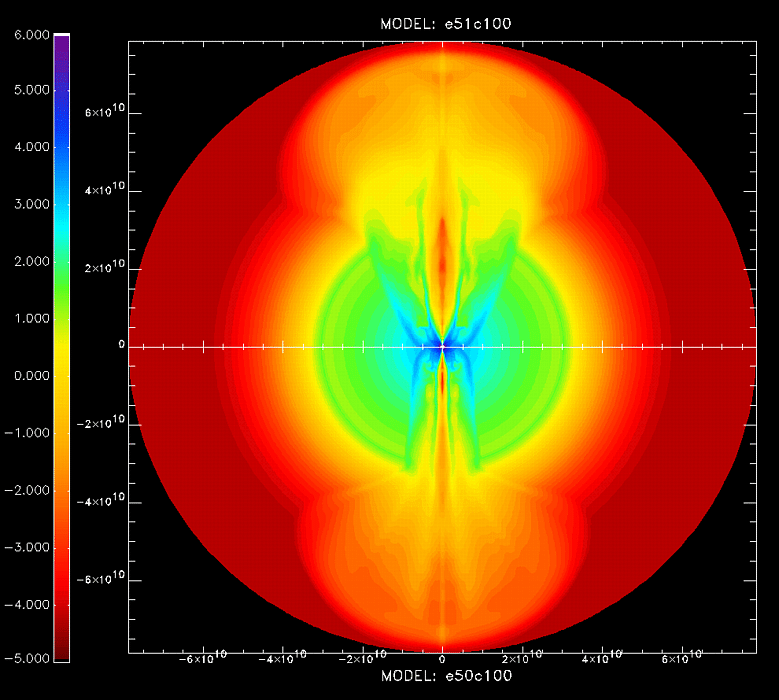Relativistic jets from collapsars and gamma-ray bursts |
|
Gamma-ray bursts (or GRB for short) are short lived sources of gamma radiation lasting from a fraction of a second to many hundreds of seconds. Recent observations have shown that GRBs are located at cosmological distances, and have a gamma-ray energy output that can be as large as 1054erg, in extreme cases. The enormous energy output makes GRBs the most powerful phenomena in the whole universe, the brightest ones being brighter than all stars in the universe for the duration of the burst. In order to produce a GRB various catastrophic collapse events have been suggested. A specific scenario is a collapsar (proposed by Stan Woosley), where the GRB is triggered by the supernova-like implosion of the rapidly rotating massive star. Its collapsing core forms a rotating black hole, which then grows by sucking in the rest of the star within about ten seconds. In a complicated process the liberated gravitational binding energy of the accreted matter leads to an energy deposition preferentially in regions near the rotation axis and close to the horizon of the black hole. This causes a collimated relativistic outflow or jet along the rotation axis which eventually gives rise to a GRB. The collapsar scenario predicts a supernova-like event, because the jet not only makes a GRB, but explodes the star, too.

|
|
Figure 1: Lorentz factor about 1.8 s after shock breakout. A Lorentz factor of 10 corresponds to a velocity of 99.5% of the speed of light. The numbers on the axes give the length in units of 100,000 km. Dashed and solid arcs mark the stellar surface and the outer edge of the exponential stellar atmosphere, respectively. The other solid line encloses matter with a radial velocity larger than 0.3c (c is the speed of light), and an internal energy density larger than 5% of the rest-mass energy. |
Astrophysicists at the MPA in collaboration with researchers from the University of Valencia in Spain and from the University of California at Santa Cruz have performed the first multi-dimensional relativistic simulations of jets from collapsars. Their simulations show the formation and propagation of a relativistic jet, and a supernova-like explosion (Figs.1 and 2). The jet reaches the stellar surface intact after having propagated over a distance of more than 200,000 kilometers. Once outside the star the jet accelerates considerably, and also starts to spread sideways leading to the formation of a mushroom-shaped bubble (Fig.1).
The jet has a very small opening angle (about 8 degrees), and possesses a highly collimated (about 1 degree), ultra-relativistic core in which the velocity is 99.97% of the speed of light about 2 s after shock breakout (Fig.1). For larger energy deposition rates, the jet and in particular its surrounding cocoon, a region of turbulent gas flow, are less collimated because a jet which is driven harder, also expands stronger laterally (Fig.2). Due to the high degree of collimation of the outflow an observer looking at the collapsar almost along the rotation axis will see a much brighter gamma-ray burst than the total energy output would produce, if it were radiated isotropically in all angular directions.

|
|
Figure 2: Rest-mass density for the models with a constant energy deposition rate of 1051 erg/s (top) and 1050 erg/s (bottom) respectively, about 1.8 s after shock breakout. The numbers on the axes give the length in units of centimeters. |
At the end of the simulations the jet has reached a radius, which is still about a thousand times smaller than the distance at which the fireball becomes optically thin. Determining the observational character of the GRB requires to compute the further evolution of the jet.
Miguel Angel Aloy,
Ewald Müller
Further information:
| MPA-Home |